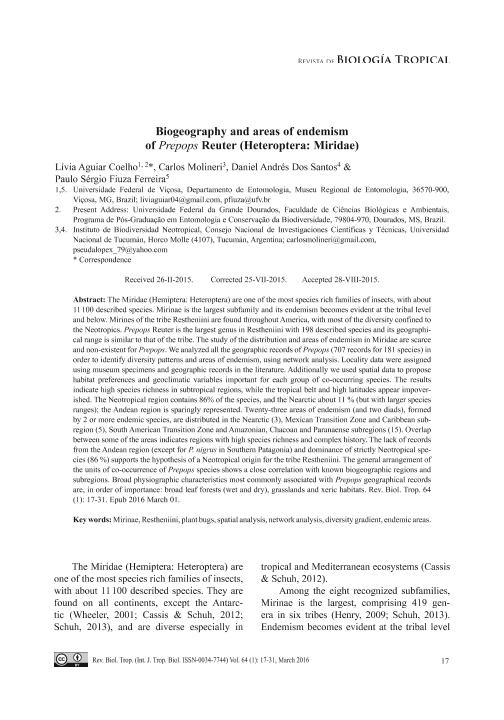Mostrar el registro sencillo del ítem
dc.contributor.author
Aguiar Coelho, Livia
dc.contributor.author
Molineri, Carlos

dc.contributor.author
Dos Santos, Daniel Andrés

dc.contributor.author
Fiuza Ferreira, Paulo Sergio
dc.date.available
2018-10-11T16:10:02Z
dc.date.issued
2016-03
dc.identifier.citation
Aguiar Coelho, Livia; Molineri, Carlos; Dos Santos, Daniel Andrés; Fiuza Ferreira, Paulo Sergio; Biogeography and areas of endemism of Prepops Reuter (Heteroptera: Miridae); Revista de Biología Tropical; Revista de Biología Tropical; 64; 1; 3-2016; 17-31
dc.identifier.issn
2215-2075
dc.identifier.uri
http://hdl.handle.net/11336/62202
dc.description.abstract
The Miridae (Hemiptera: Heteroptera) are one of the most species rich families of insects, with about 11 100 described species. Mirinae is the largest subfamily and its endemism becomes evident at the tribal level and below. Mirines of the tribe Restheniini are found throughout America, with most of the diversity confined to the Neotropics. Prepops Reuter is the largest genus in Restheniini with 198 described species and its geographical range is similar to that of the tribe. The study of the distribution and areas of endemism in Miridae are scarce and non-existent for Prepops. We analyzed all the geographic records of Prepops (707 records for 181 species) in order to identify diversity patterns and areas of endemism, using network analysis. Locality data were assigned using museum specimens and geographic records in the literature. Additionally we used spatial data to propose habitat preferences and geoclimatic variables important for each group of co-occurring species. The results indicate high species richness in subtropical regions, while the tropical belt and high latitudes appear impoverished. The Neotropical region contains 86% of the species, and the Nearctic about 11 % (but with larger species ranges); the Andean region is sparingly represented. Twenty-three areas of endemism (and two diads), formed by 2 or more endemic species, are distributed in the Nearctic (3), Mexican Transition Zone and Caribbean subregion (5), South American Transition Zone and Amazonian, Chacoan and Paranaense subregions (15). Overlap between some of the areas indicates regions with high species richness and complex history. The lack of records from the Andean region (except for P. nigrus in Southern Patagonia) and dominance of strictly Neotropical species (86 %) supports the hypothesis of a Neotropical origin for the tribe Restheniini. The general arrangement of the units of co-occurrence of Prepops species shows a close correlation with known biogeographic regions and subregions. Broad physiographic characteristics most commonly associated with Prepops geographical records are, in order of importance: broad leaf forests (wet and dry), grasslands and xeric habitats.
dc.format
application/pdf
dc.language.iso
eng
dc.publisher
Revista de Biología Tropical

dc.rights
info:eu-repo/semantics/openAccess
dc.rights.uri
https://creativecommons.org/licenses/by-nc-sa/2.5/ar/
dc.subject
Diversity Gradient
dc.subject
Endemic Areas
dc.subject
Mirinae
dc.subject
Network Analysis
dc.subject
Plant Bugs
dc.subject
Restheniini
dc.subject
Spatial Analysis
dc.subject.classification
Otras Ciencias Biológicas

dc.subject.classification
Ciencias Biológicas

dc.subject.classification
CIENCIAS NATURALES Y EXACTAS

dc.title
Biogeography and areas of endemism of Prepops Reuter (Heteroptera: Miridae)
dc.title
Biogeografía y áreas de endemismo de Prepops Reuter (Heteroptera: Miridae)
dc.type
info:eu-repo/semantics/article
dc.type
info:ar-repo/semantics/artículo
dc.type
info:eu-repo/semantics/publishedVersion
dc.date.updated
2018-10-09T20:34:19Z
dc.journal.volume
64
dc.journal.number
1
dc.journal.pagination
17-31
dc.journal.pais
Costa Rica

dc.journal.ciudad
Turrialba
dc.description.fil
Fil: Aguiar Coelho, Livia. Universidade Federal da Grande Dourados; Brasil
dc.description.fil
Fil: Molineri, Carlos. Consejo Nacional de Investigaciones Científicas y Técnicas. Centro Científico Tecnológico Conicet - Tucuman. Instituto de Biodiversidad Neotropical. Universidad Nacional de Tucuman. Facultad de Ciencias Naturales e Instituto Miguel Lillo. Instituto de Biodiversidad Neotropical. Instituto de Biodiversidad Neotropical; Argentina
dc.description.fil
Fil: Dos Santos, Daniel Andrés. Consejo Nacional de Investigaciones Científicas y Técnicas. Centro Científico Tecnológico Conicet - Tucuman. Instituto de Biodiversidad Neotropical. Universidad Nacional de Tucuman. Facultad de Ciencias Naturales e Instituto Miguel Lillo. Instituto de Biodiversidad Neotropical. Instituto de Biodiversidad Neotropical; Argentina
dc.description.fil
Fil: Fiuza Ferreira, Paulo Sergio. Universidade Federal de Viçosa; Brasil
dc.journal.title
Revista de Biología Tropical

dc.relation.alternativeid
info:eu-repo/semantics/altIdentifier/doi/https://doi.org/10.15517/rbt.v64i1.18229
dc.relation.alternativeid
info:eu-repo/semantics/altIdentifier/url/https://revistas.ucr.ac.cr/index.php/rbt/article/view/18229
Archivos asociados
